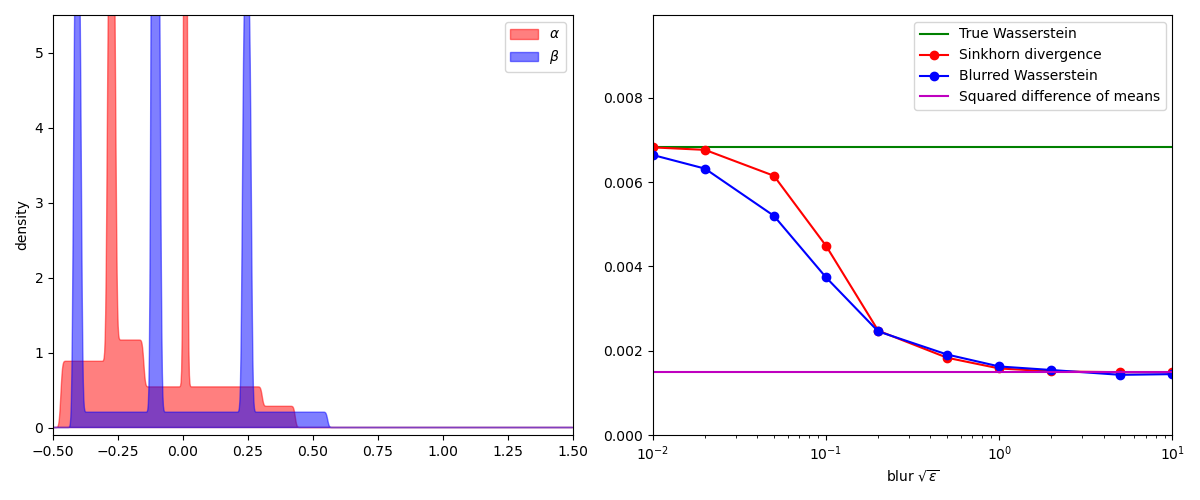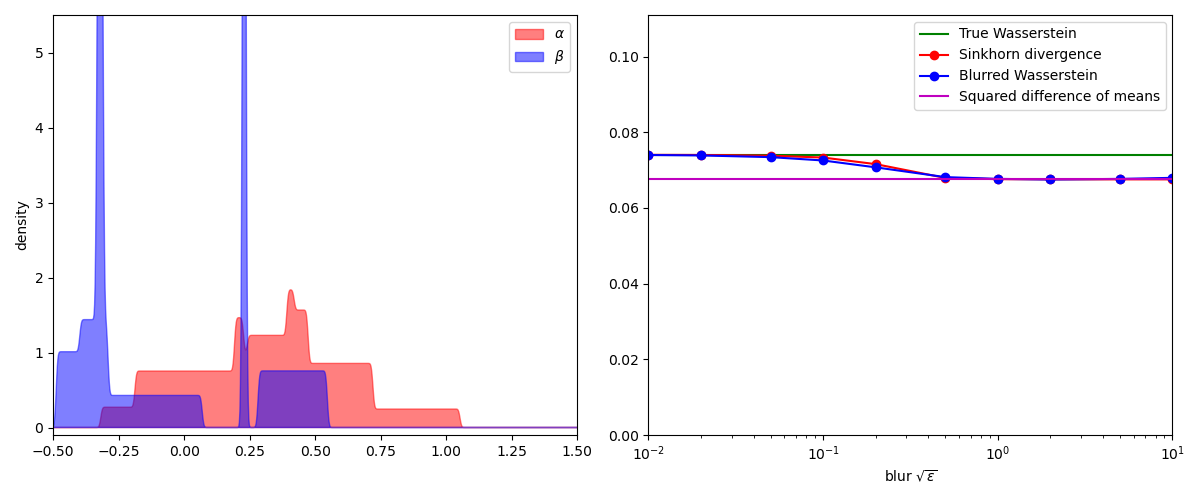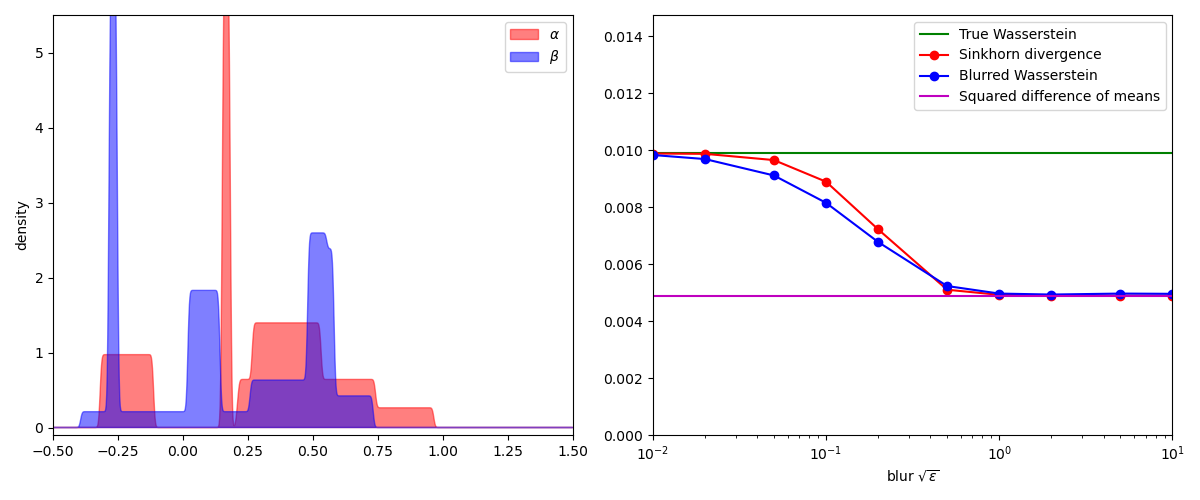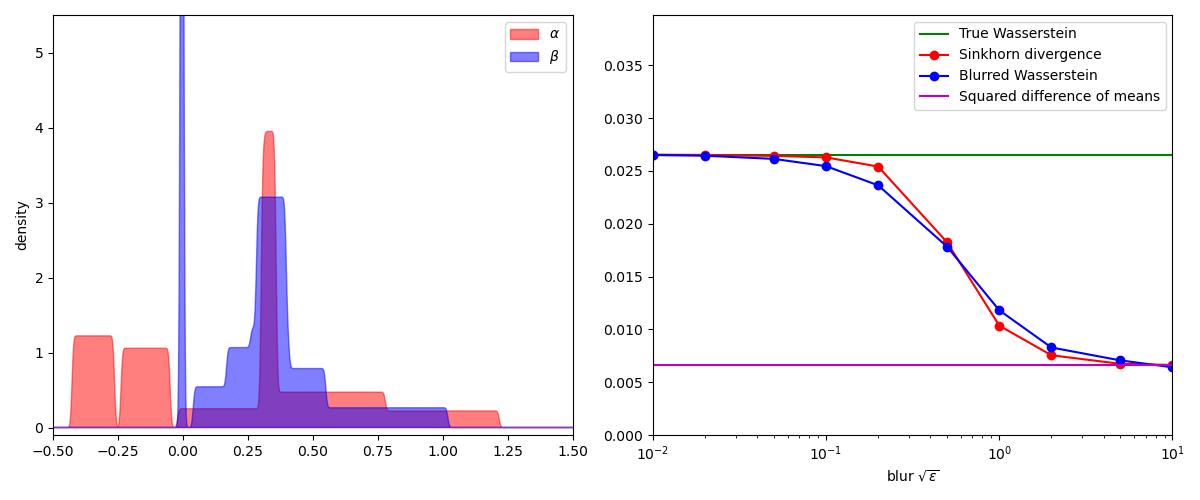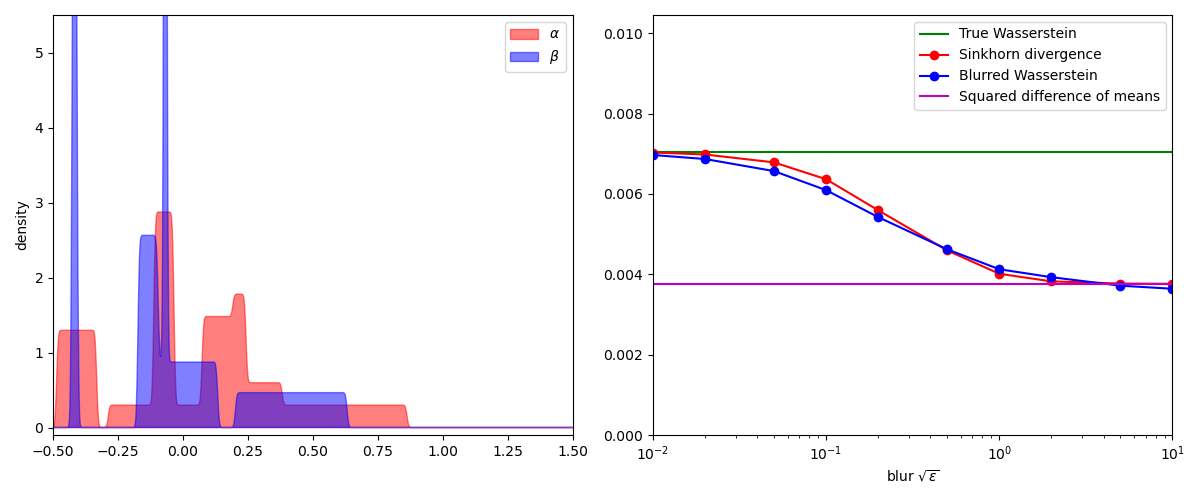Note
Go to the end to download the full example code
4) Sinkhorn vs. blurred Wasserstein distances
Sinkhorn divergences rely on a simple idea: by blurring the transport plan through the addition of an entropic penalty, we can reduce the effective dimensionality of the transportation problem and compute sensible approximations of the Wasserstein distance at a low computational cost.
As discussed in previous notebooks, the vanilla Sinkhorn loop
can be symmetrized, de-biased and turned into a genuine
multiscale algorithm: available through the
SamplesLoss("sinkhorn") layer, the Sinkhorn divergence
is a tractable approximation of the Wasserstein distance that retains its key geometric properties - positivity, convexity, metrization of the convergence in law.
But is it really the best way of smoothing our transportation problem?
When “p = 2” and
where
is a Gaussian kernel of deviation
It is the square of a distance that metrizes the convergence in law.
It takes the “correct” values on atomic Dirac masses, lifting the ground cost function to the space of positive measures:
It has the same asymptotic properties as the Sinkhorn divergence, interpolating between the true Wasserstein distance (when
Thanks to the joint convexity of the Wasserstein distance,
To compare the Sinkhorn and blurred Wasserstein divergences, a simple experiment
is to display their values on pairs of 1D measures for increasing values of
the temperature SamplesLoss("sinkhorn") layer
while the blurred Wasserstein loss
Setup
Standard imports:
import numpy as np
import matplotlib.pyplot as plt
from sklearn.neighbors import KernelDensity # display as density curves
import torch
from geomloss import SamplesLoss
use_cuda = torch.cuda.is_available()
# N.B.: We use float64 numbers to get nice limits when blur -> +infinity
dtype = torch.cuda.DoubleTensor if use_cuda else torch.DoubleTensor
Display routine:
t_plot = np.linspace(-0.5, 1.5, 1000)[:, np.newaxis]
def display_samples(ax, x, color, label=None):
"""Displays samples on the unit interval using a density curve."""
kde = KernelDensity(kernel="gaussian", bandwidth=0.005).fit(x.data.cpu().numpy())
dens = np.exp(kde.score_samples(t_plot))
dens[0] = 0
dens[-1] = 0
ax.fill(t_plot, dens, color=color, label=label)
Experiment
def rweight():
"""Random weight."""
return torch.rand(1).type(dtype)
N = 100 if not use_cuda else 10**3 # Number of samples per measure
C = 100 if not use_cuda else 10000 # number of copies for the Gaussian blur
for _ in range(5): # Repeat the experiment 5 times
K = 5 # Generate random 1D measures as the superposition of K=5 intervals
t = torch.linspace(0, 1, N // K).type(dtype).view(-1, 1)
X_i = torch.cat([rweight() ** 2 * t + rweight() - 0.5 for k in range(K)], dim=0)
Y_j = torch.cat([rweight() ** 2 * t + rweight() - 0.5 for k in range(K)], dim=0)
# Compute the limits when blur = 0...
x_, _ = X_i.sort(dim=0)
y_, _ = Y_j.sort(dim=0)
true_wass = (0.5 / len(X_i)) * ((x_ - y_) ** 2).sum()
true_wass = true_wass.item()
# and when blur = +infinity:
mean_diff = 0.5 * ((X_i.mean(0) - Y_j.mean(0)) ** 2).sum()
mean_diff = mean_diff.item()
blurs = [0.01, 0.02, 0.05, 0.1, 0.2, 0.5, 1.0, 2.0, 5.0, 10.0]
sink, bwass = [], []
for blur in blurs:
# Compute the Sinkhorn divergence:
# N.B.: To be super-precise, we use the well-tested "online" backend
# with a very large 'scaling' coefficient
loss = SamplesLoss("sinkhorn", p=2, blur=blur, scaling=0.99, backend="online")
sink.append(loss(X_i, Y_j).item())
# Compute the blurred Wasserstein distance:
x_i = torch.cat([X_i] * C, dim=0)
y_j = torch.cat([Y_j] * C, dim=0)
x_i = x_i + 0.5 * blur * torch.randn(x_i.shape).type(dtype)
y_j = y_j + 0.5 * blur * torch.randn(y_j.shape).type(dtype)
x_, _ = x_i.sort(dim=0)
y_, _ = y_j.sort(dim=0)
wass = (0.5 / len(x_i)) * ((x_ - y_) ** 2).sum()
bwass.append(wass.item())
# Fancy display:
plt.figure(figsize=(12, 5))
if N < 10**5:
ax = plt.subplot(1, 2, 1)
display_samples(ax, X_i, (1.0, 0, 0, 0.5), label="$\\alpha$")
display_samples(ax, Y_j, (0, 0, 1.0, 0.5), label="$\\beta$")
plt.axis([-0.5, 1.5, -0.1, 5.5])
plt.ylabel("density")
ax.legend()
plt.tight_layout()
ax = plt.subplot(1, 2, 2)
plt.plot([0.01, 10], [true_wass, true_wass], "g", label="True Wasserstein")
plt.plot(blurs, sink, "r-o", label="Sinkhorn divergence")
plt.plot(blurs, bwass, "b-o", label="Blurred Wasserstein")
plt.plot(
[0.01, 10], [mean_diff, mean_diff], "m", label="Squared difference of means"
)
ax.set_xscale("log")
ax.legend()
plt.axis([0.01, 10.0, 0.0, 1.5 * bwass[0]])
plt.xlabel("blur $\\sqrt{\\varepsilon}$")
plt.tight_layout()
plt.show()
Conclusion
In practice, the Sinkhorn and blurred Wasserstein divergences are nearly indistinguishable. But as far as we can tell today, these two loss functions have very different properties:
SamplesLoss("sinkhorn")layer, but has a weird, composite definition and is pretty hard to study rigorously - as evidenced by recent, technical proofs of positivity, definiteness (Feydy et al., 2018) and sample complexity (Genevay et al., 2018).
So couldn’t we get the best of both worlds?
In an ideal world, we’d like to tweak the efficient multiscale Sinkhorn algorithm
to compute the natural divergence SamplesLoss("sinkhorn") layer
as a cheap proxy for the intuitive and well-understood blurred Wasserstein distance.
In my opinion, investigating the link between these two quantities
is one of the most interesting questions left open in the field of discrete entropic OT.
The geometric loss functions implemented in GeomLoss are probably good enough
for most practical purposes,
but getting a rigorous understanding of the multiscale,
wavelet-like behavior of our algorithms
as we add small details through an exponential decay of
the blurring scale
Total running time of the script: (1 minutes 25.174 seconds)
